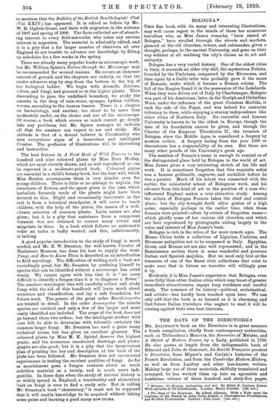BOLOGNA.* THIS fine book, with its many and interesting illustrations,
may well cause regret in the minds of those too numerous travellers who, as Miss James remarks, "have rested, at Bologna," have strolled through the streets and markets, glanced at the old churches, towers, and colonnades, given a thought, perhaps, to the ancient University, and gone on their way without at all realising the city's claims as to art and antiquity.
Bologna has a very varied history. One of the oldest cities in Italy, it succeeds an older city still, the mysterious Felsina, founded by the Umbrians, conquered by the Etruscans, and then again by a Gallic tribe who probably gave it the name of Bononia, under which it became a Roman colony. The fall of the Empire found it in the possession of the Lombards. When they were driven out of Italy by Charlemagne. Bologna was part of his dominions ; later, in the Guelph and Ghibelline Wars, under the influence of the great Countess Matilda, it took the side of the Popes, and was indeed for centuries tributary to them, while enjoying a stormy independence like other cities of Northern Italy. Its venerable and famous University is known to be the oldest in Europe, though the date of its foundation cannot be given, and though the Charter of the Bmperor Theodosius II., the treasure of Bologna since the Middle Ages, is considered .a forgery by modern critics. A forgery dating from the year 1200 or thereabouts has a respectability of its own. But there are many other proofs of the University's great age.
The mention of Francia's name is enough to remind us of the distinguished place held by Bologna in the world of art. Miss James gives a very interesting sketch of his life and work. It is sometimes forgotten that this exquisite artist was a famous goldsmith, engraver, and medallist before he was a painter. Much of his talent was connected with the earlier, the miniaturist school of Bolognese work, and his advance from this kind of art to the position of a man who influenced Raphael makes a very attractive study. Among the artists of Bologna Francia takes the chief and central place ; but the city brought forth other genius of a high order, especially perhaps in the earlier time, when those frescoes were painted—often by artists of forgotten name— which glorify some of her curious old churches, and which are here reproduced by photographs adding largely to the value and interest of Miss James's book.
Bologna is rich in the relics of far more remote ages. The Museo Civico holds a collection of Ligurian, Umbrian, and Etruscan antiquities not to be surpassed in Italy. Egyptian, Greek, and Roman art are also well represented ; and in the Renaissance section there is some wonderful and precious Italian and Spanish majolica. But we need only hint at the treasures of one of the finest civic collections that exist to make sure that in future no traveller will willingly pass it by.
Evidently it is Miss James's experience that Bologna, even more fully than other Italian cities which may boast of greater immediate attractiveness, repays long residence and careful study. The romance of its history—political, ecclesiastical, and artistic—has hardly been touched upon here. We can only add that the book is as learned as it is charming, and that future Italian travellers who neglect to read it will be sinning against their own best interests.








































 Previous page
Previous page